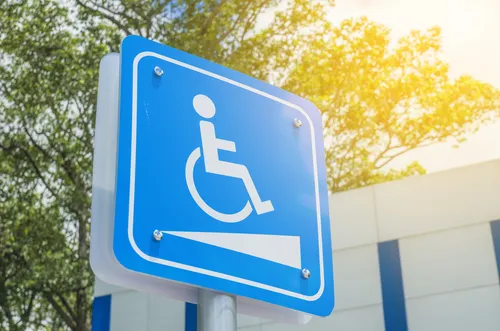 Written by Phillip McMullen II, MD, PhD
Written by Phillip McMullen II, MD, PhD
Wheelchair ramps are an essential component of mobility for people who use wheelchairs and other assistive devices like scooters or walkers. However, not just any ramp will do.
The Americans with Disabilities Act (ADA) publishes specific guidelines that apply to the design and installation of wheelchair ramps, setting standards that must be adhered to in order to ensure safety and accessibility.
But how do you know exactly what you need to do to make sure your ramp meets these standards? We’ll walk you through the guidelines to make the whole process clear, easy, and transparent. We’ll help you understand the ADA's guidelines so you can make sure that the design of your wheelchair ramp is compliant, whether you are installing it in a commercial location or at your home.

The ADA's requirements outline the proper shape, size, slope, and design of wheelchair ramps and other building components so that they can be safe and accessible for people living with disabilities.
These requirements apply to almost every aspect of wheelchair ramp design, from the slope of the ramp to its length, and they can be complicated, so it is usually a good idea to work with an experienced contractor when installing a wheelchair ramp in any location.
According to the ADA’s specifications, the slope in the direction of travel cannot exceed 1:12, meaning that for every one inch of rise, there should be 12 inches of length. Anything steeper is considered dangerous. The cross slope, which is the slope running perpendicular to the user's direction of travel, should not be any steeper than 1:48.
Whether a wheelchair ramp is portable or permanent, the ADA requires a width of at least 36 inches between the ramp’s handrails. This space must be clear and free of obstacles. Keep in mind that some states may have stricter requirements than the ADA.
ADA regulations require a maximum ramp rise of 30 inches. After 30 inches, a rest or platform must be provided.
All wheelchair ramps must include an appropriate landing at both the top of the ramp and the bottom of the ramp, and each landing must be level. If the ramp changes direction at the landing, the landing must have minimum dimensions of five feet by five feet. If the ramp does not change directions at the landing, the landing must be at least five feet long and at least as wide as the wheelchair ramp. If a landing is installed in a location that may become wet, it must be designed to prevent the accumulation of water.
To prevent users from slipping off a ramp or landing, the ADA requires edge protection on either side of the ramp wherever applicable. Ramps and landings should have a surface that extends at least 12 inches past the inside of the handrail face. Alternatively, a curb or barrier may be installed.
According to ADA regulations, you must install handrails on both sides of any wheelchair ramp that has a rise of more than six inches. If handrails are required, they must meet the following specifications:

The ADA includes specifications for wheelchair ramps for the safety of wheelchair users and other individuals that utilize these ramps to move from one location to another. For this reason, it is best to follow ADA recommendations if at all possible. In cases where you are installing a wheelchair ramp in a commercial or public space, such as a business, following ADA requirements is not optional.
If your ramp does not adhere to these requirements, you may be denied a building permit, or you may face fines or even legal consequences. If you install a ramp that doesn't meet these requirements and someone is ultimately injured as a result, you may even face legal problems. Keep in mind that you may need to follow other guidelines, depending on the laws passed by your state or local government.
In residential locations, following ADA guidelines may be more difficult or even impossible. However, for the safety of people entering and exiting your home via the ramp, it is important to follow these guidelines as closely as you can.
If space is severely limited and a compliant ramp cannot be installed, consider an alternative, such as a platform lift. Platform lifts are often a better choice for users living in very tight spaces, such as those commonly found in urban environments. Although a platform lift may be more expensive than a wheelchair ramp, it will be worth the investment if it prevents accidents and injuries. If you aren't sure whether you should install a wheelchair ramp or a platform lift, consider consulting an experienced contractor for advice.
Whether you're installing a ramp at home or for your business, following ADA specifications is the best way to ensure your finished ramp is safe, comfortable, and accessible for everyone who may need to travel it.
The ADA establishes guidelines for width, rise, slope, landings, edge protection, and handrails, though these are just the bare minimum expectations for safety. In order to make a ramp comfortable and functional, you may want to go above and beyond. That's why we recommend that any time you're going to be building a ramp you consult with a licensed contractor well-versed in ADA requirements.
Be sure to check out this article Modular Wheelchair Ramps: What You Need To Know Before You Buy! before you order a ramp.
For more information on wheelchair ramps, check out some of our other great articles like our Ultimate Wheelchair Ramp Buying Guide and 6 Amazing Reasons to Choose an Aluminum Wheelchair Ramp. And, if you're interested in our large, diverse selection of wheelchair and threshold ramps, make sure you visit our homepage at Rehabmart.com.

Phillip spent his childhood and undergraduate years in Southern Ohio, where he attended Miami University. After receiving his bachelor’s degree from this institution in 2008, he moved to Chicago to attend medical school at the University of Illinois. Phillip graduated from medical school in 2016 with his Ph.D. and M.D. He is currently completing a residency in pathology. Together, Phillip and his wife have three children. When Phillip isn’t practicing medicine, he enjoys researching and writing about a variety of topics in the medical field. He also enjoys traveling, hiking, and playing games with his family.